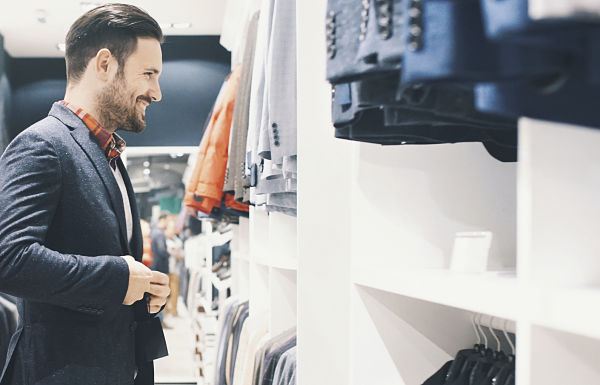Press release
An AMP Capital Shopping Centre report released today (Wednesday) found that most men actually like shopping, contrary to popular belief.
The report, titled "When is a shopping centre more than just a shopping centre?, found that not only do 79% of men like shopping, but 29% say that they love it.
It is an important message to retailers that they should pay more attention to male customers, with two-thirds of men saying they visit a shopping centre at least once a week.
Crucially, men are also spending up bigger than women when they go to the shops. About 74% of men said they are increasing the amount of cash they splash on fashion, compared with 69% of women who said the same thing.
In a powerful reminder to shopping centres to engage more directly with men, one in ten men said they would spend more money if retail was more closely geared to their interests and needs, and not just to women's.
The research used an online forum to gather initial, deeper insights, followed by a nationally rsurvey to validate the findings.
Bryan Hynes, Managing Director of AMP Capital Shopping Centres, said: “The findings of the 2016 Recommended Retail Practice Report are truly fascinating, and the report will be a great tool for retailers looking to achieve success in a highly competitive and rapidly changing market.”
In addition to highlighting the need for retailers to engage more with men, the report found that the modern shopper wants bricks-and-mortar retailers to go beyond just supplying goods or services to create a memorable experience that cannot be replicated online.
This year’s research identified five key themes and recommendations for retailers: Men vs Women, Time vs Money, Crowd vs Community, Entertainment vs Mindfulness and Somewhere vs Anywhere.
Men vs Women
Technology also has a big impact on men. The Recommended Retail Practice Report found that 27% of men would spend more with retailers who design and coordinate the online and in-store experience to make shopping more efficient and enjoyable, and 19% would spend more if technology is used to enable them to shop with more confidence and ease.
Mr Hynes said: “The male shopper has certainly been overlooked by many retailers in the past, and it’s important that we as an industry re-engage with this important group of consumers. Retailers need to do more to provide an engaging experience for men that shows they understand their wants and needs, whether it be through the physical décor of the store or by serving them with tailored communications.”
Time vs Money
Most shoppers are time poor and looking for every way possible to cut down time spent on chores and errands, in order to maximise their leisure time. The uptake of ‘self-serve’ options at supermarket checkouts and discount department stores demonstrates this. The Report found that 85% of shoppers would spend as much, or more, if shopping experiences were designed to be more efficient and easy.
However, it goes beyond just providing efficiency, the Report found that shoppers wanted be rewarded for their loyalty beyond discount cards.
About 73% of shoppers are willing to spend as much or more if retailers reward them with special experiences or customised events. Essentially, retailers need to provide a face-to-face experience that cannot be replicated online.
Mr Hynes said: “For many people, time is money. Retailers need to be looking at ways to make the process of shopping for goods as efficient as possible, while at the same time creating special experiences for shoppers who visit your store which are just as, or more, compelling than the online option.”
Crowd vs Community
It’s not just mega-brands such as Apple and Netflix who can have cult-like followings from consumers. The research showed that 84% of shoppers indicated they would spend as much, or more, if retailers made positive contributions to the community. This is a key insight, especially for smaller retailers who are looking to foster brand loyalty.
This sense of loyalty can be fostered by connecting with local shoppers on an emotional level. Burger chain, Grill’d, has effectively adopted this strategy by giving customers the opportunity to donate to a local charity when purchasing meals.
Entertainment vs Mindfulness
Consumers are looking to retailers and shopping centres to provide them with new and diverse experiences to entertain them during their trip to the shops. This helps extend their leisure time and is a great opportunity for food retailers, who have been experiencing a boom in the last few years.
In fact, the Recommended Retail Practice Report found that 82% of shoppers would spend as much or more if food experiences were designed to provide opportunities to relax and have time out.
Somewhere vs Anywhere
When it comes to bricks and mortar retail stores, the physical environment is of critical importance. Shoppers want the destination to connect with the land around it, creating seamless transition between inside and outside.
Mr Hynes said: “Retailers who can give shoppers a sense of pride in a particular place will increase both shopper engagement and sales. At AMP Capital Shopping Centres, this is referred to as our placemaking strategy.
"A great example of how we put this into practice is the recently completed $670 million redevelopment of Pacific Fair on the Gold Coast. One of the key features of the new centre is The Resort – an unrivalled open air retail precinct, filled with lush palm trees, gently running water features and secluded cabanas for visitors to stop and take in the relaxed oasis in-between shopping and dining.
"This connects the centre to its unique beachside location in a way that is elegant, yet sophisticated and warm, creating a sense of luxury that isn’t flashy or superficial.”

